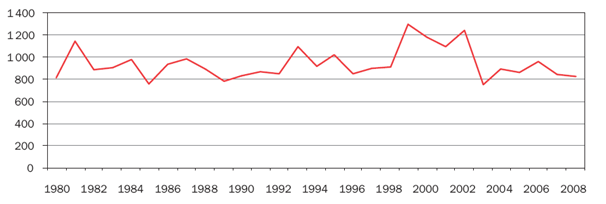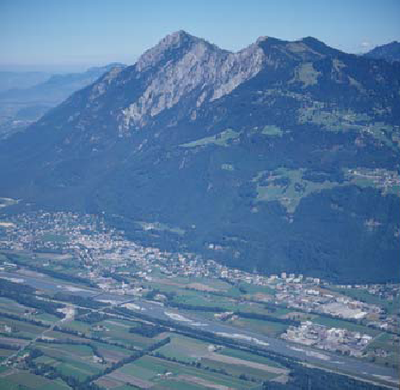What are the factors that distinguish your country from many others?
Climate
Liechtenstein enjoys a temperate continental climate. The vertical configuration of the land plays a significant role. Measurements of annual rainfall show around 900 to 1 200 mm in the valleys, with up to 1 900 mm in the alpine region. In spite of the country’s mountainous location, the climate can be described as temperate. Owing to the warming effect of the south wind (Föhn), vines and maize are successfully cultivated in the valleys. The Föhn extends the growing season in both spring and autumn.

Figure 1: Total annual precipitation (Office of Agriculture -
http://www.llv.li/pdf-llv-as-kapitel_1_raum_umwelt_und_energie_2010)

Figure 2: Total annual mean temperature (Office of Agriculture - http://www.llv.li/pdf-llv-as-kapitel_1_raum_umwelt_und_energie_2010)
Location
The Principality of Liechtenstein is a land-locked country lying between Austria and Switzerland. A high mountain range in the east forms a natural border with Austria, whilst the western border with Switzerland is formed by the Rhine. Two-thirds of the country is mountainous, while one-third consists of the densely populated Rhine Valley, on the valley plain of which nine of the total of eleven municipalities are located. Liechtenstein lies at between 430 and 2 499 m above sea level.

Figure 3: The Principality of Liechtenstein (left) and its location in the Alpine range (top right)
(Left figure: H. Schmuck, Office of Forests, Nature and Land Management - http://www.llv.li/2009_12_be_cbd_nationaler_bericht_endversion_en.pdf; right figure: www.freytagberndt.de).


Figure 4: The physical regions of Liechtenstein: Rhine Valley plain and forested Rhine Valley slopes (left image),
mountain region (right image) (Office of Forests, Nature and Land Management - http://www.llv.li/2009_12_be_cbd_nationaler_bericht_endversion_en.pdf - Photographs: E. Ritter)
Population
With a population of around 36 000 inhabitants, Liechtenstein is one of the smallest states in Europe and the world. The number of inhabitants has almost tripled since 1950, primarily as a result of immigration. The population is distributed throughout eleven municipalities with a total area of 160 km2. The population density is 222 inhabitants per km2.
One-third of the population is of foreign nationality, primarily Swiss, Austrian and German. The foreign population is substantially younger than that of Liechtenstein nationals. Compared with other European states, persons of working age (20 to 64 years old) are represented to an above-average degree. By contrast, the proportions of children and elderly people in the population are below average.

Figure 5: Population 1901-2007
(Office for Statistics 2009 -
http://www.llv.li/t-llv-as-kapital_2_bevoelkerung_und_wohnverhaeltnisse_2010)
Form of government
The Principality of Liechtenstein is a constitutional hereditary monarchy on a democratic and parliamentary basis. State authority resides in the prince and in the people. The relatively strong position of the prince is balanced by far-reaching direct-democratic rights on the part of the people.
Economy
Liechtenstein has a highly diversified national economy (employment by economic sectors at the end of 2007: industry and manufacturing 39 %, general services 23 %, financial services 31 %, agriculture and public sector 6 %) and is strongly export-oriented.
The most important advantages of the country’s location include its geographically central position and its access to highly skilled professionals from the Lake Constance region.
More than one-half of the people employed in Liechtenstein live abroad. Such commuters make a major contribution to the production of the national economy of Liechtenstein and thus to its GDP. For the year 2007, gross domestic product amounted to around CHF 5.5 billion (CHF 155 000 per inhabitant). With a growth rate of 10.1 % at current prices, GDP rose dramatically again. In 1998 it was still only CHF 3.6 billion.
The international financial and economic crisis led the national economy of Liechtenstein into a sharp recession towards the end of 2008. In the meantime, however, early signs of stabilisation are to be seen. The gross domestic product for 2009 is expected to be substantially lower than in the record year of 2007.
Environmental Governance
Environmental policy in Liechtenstein is fundamentally the responsibility of The Ministry of Environmental Affairs, Land Use Planning, Agriculture and Forestry. The Amt für Umweltschutz [Office for Environmental Protection] is in charge of ensuring compliance with legislation in the field of technical environmental protection (new Environmental Protection Law of 2008), whilst the Amt für Wald, Natur und Landschaft [Office for Forestry, Nature and Land Management] is responsible for nature conservation.
Relations between Liechtenstein and Switzerland are very close and strongly shaped by the Customs and Monetary Treaties between the two countries (Customs and Monetary Union). The Customs Treaty with Switzerland has a significant impact on environmental and fiscal strategies. Many Swiss environmental provisions (e.g. environmental standards) are applicable also in Liechtenstein or are implemented into Liechtenstein law on the basis of specific international treaty rules.
At the same time, Liechtenstein, by joining the European Economic Area (1995), has implemented a large proportion of EU legislation and participated in various EU programmes.






Document Actions
Share with others